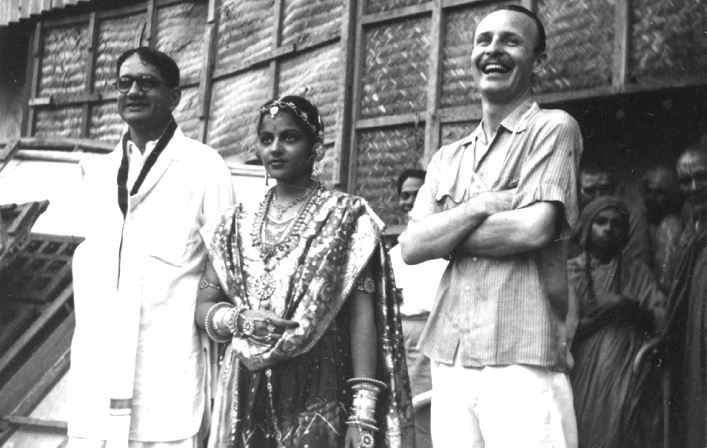Registered with the Registrar of Newspapers for India under R.N.I 53640/91
Vol. XXX No. 10, September 16-30, 2020
To MS, with Gratitude
by Balakesari Komattil
M.S. Subbulakshmi was born on September 16, 1916. We publish this article as a tribute to a great artiste.
Standing on the balcony of his house, a four year old was humming the tuneful notes of Kaatriniley Varum Geetam, the latest MS hit from the film Meera, blissfully unaware that his solo performance was being keenly watched from behind by his musically savvy grandmother, mother and a couple of aunts. The applause that followed however brought the impromptu performance to a bashful and abrupt end.
That was not my first brush with MS’s music. Family lore has it that, as a toddler, the only way to prevent me from screaming my head off was to play one of the MS ‘plates’ (as gramophone records were called in those days). The favourites were Kandathundo Kannan pol puviyil and Vaanathin meethu mayil aada kanden – that evergreen classic of Subhramanya Bharathi. Sometimes, providing a touch of comedy, this exercise had to be carried out in the dead of the night by my mother and an aunt hurriedly relocating the hand-cranked phonograph to the corner of a spacious bathroom, to avoid disturbing my short-tempered grandfather. But then, the MS effect was the same anywhere!
With such early exposure to the music of one of the brightest stars of Carnatic music firmament at that time, one might have thought that my musical talents would have blossomed into something more than the ordinary. That, however, was not to be. So, here I am today, not even a head-nodding, thigh-slapping connossieur, who can disdainfully pick holes into the most melodious (for untrained ears) of concerts, but a mere pedestrian “enjoyer” of quality, wholesome music. The fact is, I have to perhaps thank MS for even that modest ability.
It was a fortunate coincidence for me that my early formative years coincided with one of the most critical phases in MS’s career, when she transcended from being an outstanding exponent of Carnatic music, catering to a predominantly discriminative, albeit local, audience to a popular singer of national prominence. The vehicle that launched her on to the national stage was undoubtedly the Hindi version of the film Meera. It was, however the Tamil original that caught my childhood fancy.
To the lyrical genius of Kalki Krishnamurthi and the musical versatility of S.V. Venkataraman – details which I learnt much later – MS with her remarkably dexterous and mellifluous voice and faultless diction literally breathed life into each of the songs in that most musical of films: songs, which even a pre-schooler, could enjoy. Whether it was the nostalgia-evoking Andha naalum vandhidatho in simple alliterative Tamil or the exuberantly evocative Giridhara Gopala in chaste Sanskrit or the joyful chorus of Kannan leelaigal seivaane, it was difficult to separate Meera and MS or so it seemed to an impressionable child.
MS covered the whole range of emotions musically in songs as varied as the soaringly happy Marainda koondil irundu to the hauntingly sad Udal uruga. The most popular was of course the melodious Kaatriniley. For me the songs provided much needed release from the forbidding shackles of the newly started school routine.
The forties were as eventful in the history of the nation as they were to a child born into and growing up in that decade.
The War, the Quit India Movement, the Evacuation of Madras, the Partition, the run up to Independence and finally the assassination of Mahatma Gandhi provided the tumultuous back drop against which Madurai Shanmukhavadivu Subbulakshmi became MS and rose to national prominence first as the saint poetess in Meera and then through her soulful renderings of Gandhiji’s favourite bhajans such as Vaishnava Jana to and Hari Thum Haro and the Ram Dhun in her own typical South Indian-Hindustani hybrid style. Not surprisingly, it is MS’s renderings of the Mahatma’s favourites that evoke in me memories even today of the passing away of Gandhiji, as they first did to me as a first- grader seven decades ago.
Today, I still cannot distinguish a todi from a khamboji, yet I can sit through a classical concert quietly lapping up the music; I am more comfortable listening to a Thyagaraja Bhagavatar, a Saigal or a Pankaj Mullick or to the strains of a Lalgudi’s violin, a Ravi Shankar’s sitar or the piano notes of a Beethoven composition – in short, any music that is elevating rather than titillating. If it is true that one’s basic character is shaped predominantly by the influences during first four to five years of one’s life, then I, a ‘classical’ ignoramus, would like to believe that MS unwittingly gifted that modest ability to me, though she was not even aware that I existed.
So, to MS with gratitude, wherever she is today, I can only call out in her own inimitable Meera style:
(Isai ulagil) Engum niraindaaye
Inru engu maraindaayo?
* Originally written sometime in 2005.
 Photographer Glen Hensley’s picture titled leading man and leading lady – a photo taken on the sets of the Tamil musical classic Meera, showing Kalki Sadasivam, MS and the director of the film Ellis Dungan.
Photographer Glen Hensley’s picture titled leading man and leading lady – a photo taken on the sets of the Tamil musical classic Meera, showing Kalki Sadasivam, MS and the director of the film Ellis Dungan.
